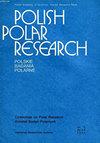New record and new species of lichenized fungal genus Candelariella Müll. Arg. in Antarctica
IF 0.8
4区 地球科学
Q4 ECOLOGY
引用次数: 1
Abstract
: Previously, only three Candelariella species were known from Antarctica: C. aurella , C. flava and C. vitellina . After morphologically and phylogenetically examining our collections on soil from James Ross Island, located in the north-east Antarctic Peninsula region, and Horseshoe Island, a small rocky island in Bourgeois Fjord, Marguerite Bay in the south-west Antarctic Peninsula, we describe the lichen species Candelariella ruzgarii as new to science. Sequences of the nrITS, mtSSU and RPB1 gene regions of the new species were amplified and revealed that the phylogenetic position of the new species is in the C. aurella group, which is characterised by 8-spored asci and ± granular thalli. Candelariella ruzgarii is phylogenetically most closely related to C. aurella s. lat. but differs mainly in ecology as the new species grows on soil or on terricolous lichens, whereas the latter species grows on calcareous rocks, rarely on wood. Morphologically, C. ruzgarii is very similar to C. aggregata , a Northern Hemisphere species that grows on mosses and plant debris. Apart from the different phylogenetical position, C. ruzgarii has a thicker and sometimes slightly crenulated thalline margin and somewhat shorter ascospores than C. aggregata . We also report C. plumbea for the first time from Antarctica, a species with a thick and grey thallus that was previously known from Europe and Asia.地衣真菌Candelariella Müll属的新记录和新种。Arg。在南极洲
本文章由计算机程序翻译,如有差异,请以英文原文为准。
求助全文
约1分钟内获得全文
求助全文
来源期刊

Polish Polar Research
ECOLOGY-GEOSCIENCES, MULTIDISCIPLINARY
CiteScore
2.00
自引率
7.70%
发文量
0
审稿时长
>12 weeks
期刊介绍:
The quarterly Polish Polar Research edited by the Committee on Polar Research of the Polish Academy of Sciences is an international journal publishing original research articles presenting the results of studies carried out in polar regions.
All papers are peer-reviewed and published in English.
The Editorial Advisory Board includes renowned scientist from Poland and from abroad.
 求助内容:
求助内容: 应助结果提醒方式:
应助结果提醒方式:


